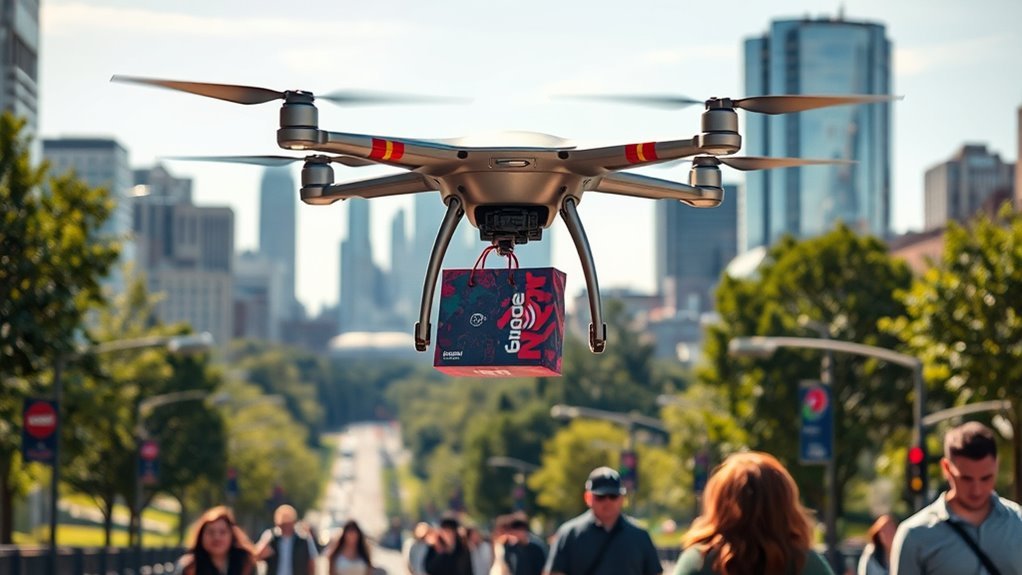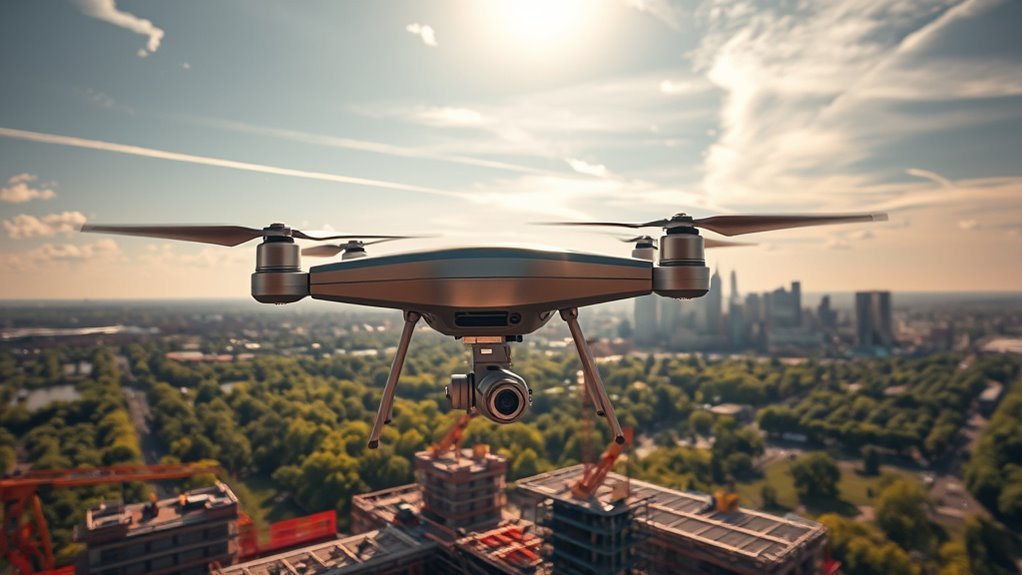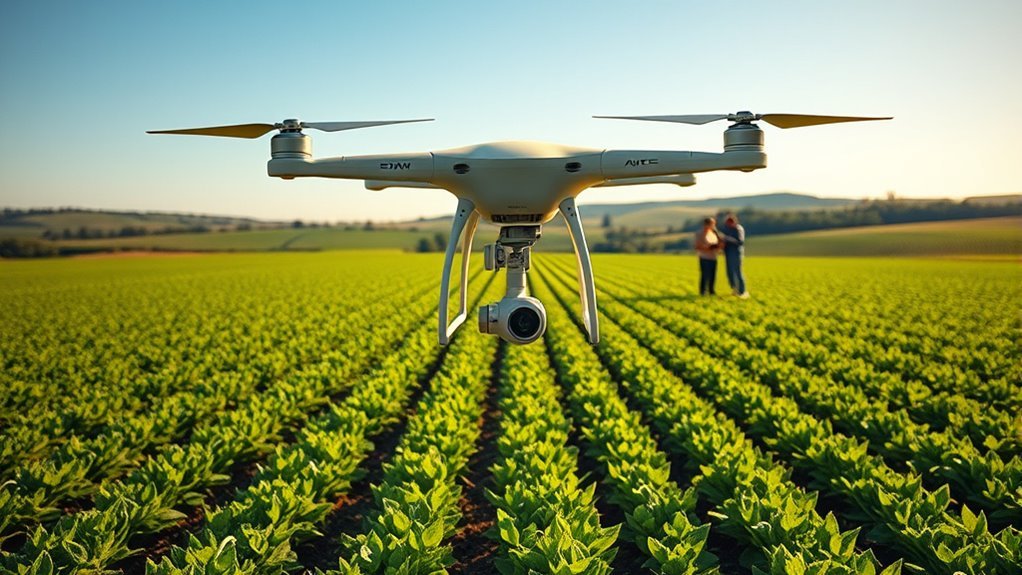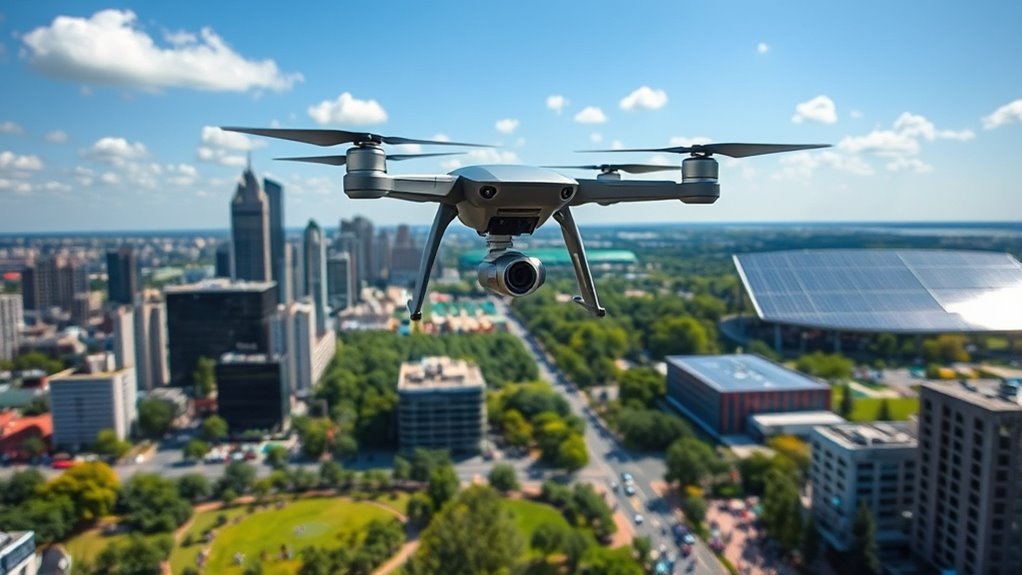In 2025, innovations in drone technology are reshaping New Jersey’s landscape. Drones are streamlining delivery services, enabling fast and efficient last-mile logistics. They’re also revolutionizing infrastructure inspections, offering high accuracy and cost savings. Agriculture benefits from real-time data for crop monitoring, while advanced environmental monitoring enhances ecological practices. Plus, AI integration optimizes drone operations. Regulatory changes facilitate this growth, leading to new job opportunities and economic benefits. Discover how these advancements further impact various sectors.
Advancements in Drone Delivery Services

As technology continues to evolve, drone delivery services in New Jersey are rapidly transforming the way you receive goods. These advancements are reshaping last mile logistics, making urban delivery faster and more efficient. Imagine placing an order and having it arrive at your doorstep within minutes, bypassing traffic and congestion. Drones offer a unique solution, especially in densely populated areas, where traditional delivery methods often struggle. By utilizing advanced navigation systems and automated flight paths, these drones enhance service reliability and reduce operational costs. Lucid Drones’ advanced AI algorithms enable them to optimize flight paths and adapt to real-time environments, ensuring you can enjoy the freedom of quick access to essential items without the hassle of waiting. As these services continue to expand, your everyday life will become increasingly streamlined, giving you more time to focus on what truly matters. Enhanced safety features ensure that these drones operate reliably, further boosting consumer confidence in this innovative delivery method.
Drones in Infrastructure Inspections

The rise of drone technology isn’t just revolutionizing delivery services; it’s also making waves in infrastructure inspections across New Jersey. Drones are providing unprecedented inspection accuracy, allowing you to assess bridges, roads, and buildings like never before. With high-resolution cameras and advanced sensors, these aerial devices can identify structural issues that traditional methods might miss. Plus, they reduce the need for labor-intensive inspections, saving both time and money. However, drone maintenance is essential to guarantee their reliability and effectiveness. Regular check-ups keep them in top shape, assuring that you get accurate data every time. As you embrace these innovations, you’ll find that drones are transforming how you maintain and inspect critical infrastructure across the state. Moreover, automated monitoring techniques provide real-time data analysis, enhancing the efficiency of inspection workflows. Additionally, drones equipped with multiple sensors offer seamless data collection on environmental conditions, further improving infrastructure assessment capabilities.
Agricultural Innovations Through Drones

While traditional farming methods have served well for decades, integrating drone technology into agriculture is proving to be a game changer in New Jersey. Drones are revolutionizing crop monitoring, allowing you to assess field health quickly and efficiently. With high-resolution imagery and real-time data, you can detect issues like pests or nutrient deficiencies before they escalate. This level of precision agriculture empowers you to make informed decisions, optimizing yields and reducing waste. By leveraging drone technology, you can not only enhance productivity but also promote sustainable practices that align with your desire for freedom in managing your farm. Embracing these innovations means you’re not just keeping pace; you’re leading the way toward a more efficient and environmentally friendly agricultural future. The multispectral sensors integrated into advanced drones provide essential insights into crop health, enabling early interventions for issues that could otherwise go unnoticed. Additionally, advanced drone technology enhances the accuracy of data collection, further supporting effective management strategies in your farming operations.
Enhancing Environmental Monitoring With Drones
With drones, you’re now able to collect real-time data that revolutionizes environmental monitoring. Whether it’s evaluating wildlife habitats or tracking pollution levels, these aerial tools provide insights that were once difficult to obtain. As you explore the capabilities of drones, you’ll see how they can greatly enhance your understanding of ecological health in New Jersey. Furthermore, drones equipped with high-quality imaging allow for precise assessments of environmental changes and trends over time. Additionally, the use of drones for real-time data analysis enables quicker responses to ecological issues, fostering better decision-making and sustainable practices.
Real-Time Data Collection
As environmental challenges grow increasingly complex, leveraging drones for real-time data collection has become a game-changer in monitoring ecosystems. You might be amazed at how advanced sensor technology on drones enhances data accuracy, allowing for precise assessments of air quality, water levels, and vegetation health. This real-time capability empowers you to make informed decisions quickly, fostering an agile response to environmental changes. Imagine monitoring pollution levels or tracking deforestation without the limitations of traditional methods. Drones give you the freedom to collect vast amounts of data efficiently, transforming the way we perceive and protect our natural resources. By harnessing these innovations, you’re actively participating in creating a more sustainable future for New Jersey and beyond.
Wildlife Habitat Assessment
The use of drones in real-time data collection naturally extends to wildlife habitat assessment, revolutionizing how we monitor and understand ecosystems. With advanced capabilities in habitat mapping and species monitoring, drones offer a bird’s-eye view of our precious environments. They enable you to efficiently collect data on wildlife patterns, ensuring every species thrives in its natural habitat.
| Aspect | Drones | Traditional Methods |
|---|---|---|
| Efficiency | High | Low |
| Coverage Area | Extensive | Limited |
| Data Accuracy | Precise | Variable |
| Cost | Affordable Over Time | Often Expensive |
Pollution Tracking Solutions
While traditional methods of pollution tracking often struggle with timeliness and accuracy, drones are emerging as a game-changer in environmental monitoring. You can leverage these advanced technologies for air quality monitoring, providing real-time data on pollutants and their sources. Drones equipped with specialized sensors can cover vast areas quickly, gathering vital information that helps assess environmental impact more effectively than ever before. This capability allows you to respond proactively to pollution threats, ensuring the well-being of your community and natural resources. With their ability to deliver precise data at a fraction of the cost, drones empower you to take control of environmental stewardship, fostering a healthier, more sustainable future that aligns with your desire for freedom and accountability in ecological management.
The Role of Artificial Intelligence in Drone Technology
Artificial intelligence is transforming drone technology in ways that were once considered the domain of science fiction. With AI algorithms powering advancements in drone autonomy, you’re witnessing a new era of flight. Here are three impactful innovations:
Artificial intelligence is revolutionizing drone technology, ushering in a new era of autonomous flight and unprecedented capabilities.
- Autonomous Navigation: Drones can now navigate complex environments without human intervention, providing unprecedented freedom.
- Intelligent Mapping: Using computer vision and machine learning, drones create detailed maps, revolutionizing industries like agriculture and construction.
- Predictive Analytics: AI processes vast data, enabling proactive decision-making and efficient operations.
These innovations enhance data processing capabilities and make drones smarter, leveraging real-time insights for superior performance. As you embrace these advancements, you’ll find yourself at the forefront of a technological revolution, experiencing the true potential of drone technology in New Jersey. Additionally, urban airspace management plays a crucial role in optimizing the integration of drones into existing transport systems.
Regulatory Changes Supporting Drone Integration
As drone technology continues to evolve, regulatory changes are essential for fostering its seamless integration into everyday operations. In New Jersey, updated regulatory frameworks are emerging to enhance safety while encouraging innovation. You’ll find that streamlined drone licensing processes make it easier for businesses and hobbyists alike to operate drones legally and responsibly. Compliance with drone registration requirements ensures that operators are accountable for their equipment and operations. These changes not only promote safety but also empower you to explore new possibilities in various sectors, from agriculture to delivery services. As regulations adapt to accommodate advancements, you can enjoy greater freedom in deploying drones for a variety of applications. Ultimately, these regulatory shifts pave the way for a future where drones are an integral part of daily life in New Jersey. Additionally, compliance with local laws ensures a safe and responsible drone experience.
Drones in Emergency Response and Disaster Management
In emergency situations, drones are transforming how responders act, offering real-time surveillance that enhances situational awareness. Imagine the potential of rapid medical supply delivery and how it can make a vital difference in saving lives. Additionally, their role in search and rescue operations is becoming indispensable, providing essential support when every second counts. Drones also deliver critical supplies to hard-to-reach areas during disasters, ensuring that essential items can be transported directly where they are needed most. Their intelligent flight modes enable precise navigation and flexibility during complex missions, further enhancing their effectiveness in critical scenarios.
Real-time Surveillance Capabilities
While traditional methods of emergency response can often be slow and cumbersome, the integration of drones equipped with real-time surveillance capabilities is revolutionizing disaster management in New Jersey. These drones enable first responders to gather essential information quickly and efficiently, enhancing safety and effectiveness during crises.
Here’s how real-time monitoring makes a difference:
- Increased Visibility: You can see the entire landscape of a disaster area, identifying hazards or victims faster.
- Enhanced Security Applications: Drones can monitor affected regions, preventing looting and ensuring safety for responders and civilians alike.
- Rapid Assessment: They provide immediate data that helps in resource allocation and decision-making during emergencies.
With these advancements, you can feel a renewed sense of freedom knowing that help is more effective and timely in your community.
Rapid Medical Supply Delivery
When emergencies strike, every second counts, making rapid medical supply delivery via drones a game-changer in New Jersey’s disaster response efforts. By leveraging advanced medical drone logistics, these unmanned aerial vehicles can swiftly transport critical supplies—like medications and blood—directly to healthcare facilities or even the scene of an emergency. This capability greatly enhances supply chain optimization, reducing the time it takes to get essential resources into the hands of those who need them most. Imagine a world where lifesaving supplies can be delivered in minutes rather than hours, especially in hard-to-reach areas. As New Jersey embraces this innovative technology, it’s not just about speed; it’s about ensuring that freedom from preventable harm becomes a reality for everyone in times of crisis.
Search and Rescue Operations
As search and rescue operations evolve, drones have emerged as a pivotal tool in enhancing emergency response and disaster management in New Jersey. With advancements in drone technology, you’ll find that these devices are revolutionizing how we approach crises. Here are three key benefits:
- Rapid Deployment: Drones can reach remote locations faster than traditional rescue teams, saving precious time.
- Real-Time Data: Equipped with high-resolution cameras, drones provide live feeds, allowing responders to assess situations better.
- Safety First: By scouting dangerous areas, drones protect human lives, minimizing risk during rescues.
Incorporating drones into emergency preparedness isn’t just about technology; it’s about embracing freedom from constraints, ensuring that help is always just a flight away.
The Economic Impact of Drones on New Jersey’s Workforce
Although the integration of drones into various sectors might seem like a futuristic concept, their impact on New Jersey’s workforce is already profound. Drones are revolutionizing industries like agriculture, construction, and logistics, creating a robust drone workforce that’s essential for economic growth. As businesses adopt these technologies, they’re not just enhancing efficiency; they’re also generating new job opportunities and requiring specialized training. You’ll find roles emerging in drone piloting, data analysis, and maintenance, catering to a workforce keen for freedom and innovation. This shift not only promotes economic stability but also empowers individuals to explore new career paths. Embracing drone technology can lead to a dynamic job market, fostering a culture of adaptability and entrepreneurial spirit in New Jersey. Additionally, the use of drones enhances real-time monitoring capabilities, allowing companies to optimize operations and improve safety measures. The superior range of Amazon Prime Air drones supports logistics efficiency, enabling quicker deliveries and improved service in the state’s bustling urban centers.
Frequently Asked Questions
How Are Drones Affecting Local Wildlife in New Jersey?
Drones are revolutionizing wildlife conservation in New Jersey. By employing drone monitoring, you can track animal movements without disturbing their habitats, ultimately leading to more effective conservation strategies and healthier ecosystems for local wildlife.
What Are the Potential Risks of Drone Usage?
You might not realize it, but drone usage brings potential risks like privacy invasion and accidents. To mitigate these, it’s vital to follow drone regulations and implement safety measures, ensuring freedom without compromising safety.
How Are Drones Being Used in Education and Training?
Drones are revolutionizing education through innovative drone curriculum and aerial workshops. You’ll find students engaged in hands-on experiences, mastering skills that foster creativity and technological proficiency, preparing them for a future filled with limitless possibilities.
What Privacy Concerns Exist With Drone Technology?
You can’t ignore the privacy concerns surrounding drones. Issues like surveillance ethics and data security raise valid questions about personal freedom and how data collected might be misused, sparking debates on regulation and responsible use.
How Can Individuals Get Involved in Drone Innovation?
Ever thought about joining the drone revolution? You can participate in community workshops and drone competitions, where you’ll learn skills, connect with enthusiasts, and help shape the future of this exciting technology. Get involved today!

